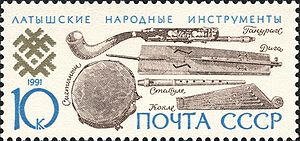- Music of Latvia
-
Traditional Latvian music is often set to traditional poetry called dainas, featuring pre-Christian themes and legends, drone vocal styles and Baltic zithers.
Contents
Dainas
Dainas are very short, usually only one or two stanzas, unrhymed and in a four-footed trochaic metre. Lyrically, dainas concern themselves with native mythology but, in contrast to most similar forms, do not have any legendary heroes. Stories often revolve around pre-Christian deities like the sun goddess Saule, the moon god Meness and, most notably, the life of people, especially its three most important events - birth, wedding and death (including burial). The first collection of dainas was published between 1894 and 1915 as Latvju Dainas by Krišjānis Barons.
Instrumentation
Accompaniment to the village songs is played on various traditional instruments, the most important of which is the kokle, a type of zither related to the Finnish kantele. In the 1970s, artists like Jānis Porikis and Valdis Muktupāvels led a revival in kokle music, which had only survived in the Courland/Kurzeme and Lettgallia/Latgale regions. The Latvian-exile community abroad, especially in the United States, has also kept kokle traditions alive. In the last hundred years a new kind of kokle was developed, with many more strings, halftones levelers and other improvements that expand the capacities of the instrument to play not only modal music but, in other point of view, displeased more traditional musicians. This kind of instrument its called "concert kokle". However, there is currently only one concert kokle maker left, though he is to begin training apprentices with the help of EU grants.
Popular music
During the Soviet occupation, rock music became extremely popular, because it, as well as folk songs, offered a chance to rebel against the local authorities. Imants Kalniņš was the most important composer of the time, and his songs were extremely popular. He also wrote music for the movie originally called Četri balti krekli ('Four White Shirts'), later given the title Elpojiet Dziļi! ('Breathe Deep!'), which spoke about the need of freedom and was therefore banned. One of the most important social gatherings of the time was the annual Imantdiena ('The Day of Imants (Kalnins)'), forbidden on grounds of interfering with hay-gathering. The tradition continued informally at the composer's house.
The songs of Imants Kalniņš were best known as performed by the Menuets group which only played songs by this composer. Most of the members of the group moved on to form another group, Pērkons ('Thunder') later. Pērkons was a symbol of rebellion. They played rock and roll music, using poems mostly written by Māris Melgalvs. Many of those were strongly disapproved by the Soviet authorities, as they implied the ridiculousness of the system. The most famous concert by Pērkons resulted in the destruction of a train compartment by the young people who had attended the concert. This, as well as other events, is portrayed in the movie Vai viegli būt jaunam? ('Is It Easy to Be Young?') by Juris Podnieks. Acts such as Pērkons certainly played an important role in the lives of the youth of the time and were a serious challenge to the Soviet system.
Nowadays, the pop music sphere is dominated by pop music (e.g., Prāta vētra, also known as Brainstorm) and alternative rock.
List of composers and bands in Latvia
Composers of contemporary music (see http://www.music.lv/en/lmuza.asp?action=personalities) Rock or (and) Pop Other - Maija Einfelde,
- Imants Kalniņš,
- Indra Riše,
- Jānis Lūsēns,
- Jānis Petraškēvičs,
- Mārtiņš Brauns,
- Pēteris Plakidis,
- Pēteris Vasks,
- Mārtiņš Viļums,
- Rihards Dubra,
- Romualds Kalsons,
- Juris Karlsons,
- Andris Dzenītis,
- Santa Ratniece
- Uģis Prauliņš
- 100. debija, A-Eiropa, Ainars Mielavs, Aisha
- Aparāts, Autobuss Debesīs, Astro'n'out,
- Bet Bet, Borowa MC, Collide,
- Detlef, Device, Dun Dun,
- Double Faced Eels, Eolika, Ella, Dzeltenie Pastnieki,
- F.L.Y., Helēna Kozlova, Hospitāļu iela,
- Iļģi, Imants Kalniņš, Fomins & Kleins,
- Iedomu spārni, Ieva Akurātere, Igo, Jauns Mēness,
- Jānis Žilde, Jumprava, Kaspars Dimiters, Kārlis Kazāks,
- Lauris Reiniks, Labvēlīgais tips, Lādezers, Linda Leen,
- Līvi, Logo, Marana, Marija Naumova,
- Menuets, Mirta, Mofo, Zigfrīds Muktupāvels
- Oceanfall, Olive Mess, Pērkons, Pienvedēja Piedzīvojumi,
- Raimonds Pauls, Gunārs Rozenbergs, Prāta Vētra, Punch, R.A.P, RePublic,
- Uldis Stabulnieks, Skumju Akmeņi, Satellites LV, Skyforger, SoundArcade,
- The Mundane, Tranzīts, Tumsa, Vilki, Z-Scars
- Tumors,
- 2tie,
- SoundArcade,
- Matīss Akuraters
Music of Europe Sovereign
states- Albania
- Andorra
- Armenia
- Austria
- Azerbaijan
- Belarus
- Belgium
- Bosnia and Herzegovina
- Bulgaria
- Croatia
- Cyprus
- Czech Republic
- Denmark
- Estonia
- Finland
- France
- Georgia
- Germany
- Greece
- Hungary
- Iceland
- Ireland
- Italy
- Kazakhstan
- Latvia
- Liechtenstein
- Lithuania
- Luxembourg
- Macedonia
- Malta
- Moldova
- Monaco
- Montenegro
- Netherlands
- Norway
- Poland
- Portugal
- Romania
- Russia
- San Marino
- Serbia
- Slovakia
- Slovenia
- Spain
- Sweden
- Switzerland
- Turkey
- Ukraine
- United Kingdom
- (England
- Northern Ireland
- Scotland
- Wales)
- Vatican City
States with limited
recognition- Abkhazia
- Kosovo
- Nagorno-Karabakh
- Northern Cyprus
- South Ossetia
- Transnistria
Dependencies
and other territories- Åland
- Faroe Islands
- Gibraltar
- Guernsey
- Jan Mayen
- Jersey
- Isle of Man
- Svalbard
Other entities Nordic music References
- Cronshaw, Andrew. "Singing Revolutions". 2000. In Broughton, Simon and Ellingham, Mark with McConnachie, James and Duane, Orla (Ed.), World Music, Vol. 1: Africa, Europe and the Middle East, pp 16–24. Rough Guides Ltd, Penguin Books. ISBN 1-85828-636-0
External links
- (French) Audio clips: Traditional music of Latvia. Musée d'Ethnographie de Genève. Accessed November 25, 2010.
- BBC: Latvia celebrates national instrument: the kokle
Categories:- Latvian music
Wikimedia Foundation. 2010.

